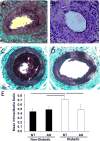Upregulation of miR-221 and -222 in response to increased extracellular signal-regulated kinases 1/2 activity exacerbates neointimal hyperplasia in diabetes mellitus
- PMID: 29276985
- PMCID: PMC5812823
- DOI: 10.1016/j.atherosclerosis.2017.12.016
Upregulation of miR-221 and -222 in response to increased extracellular signal-regulated kinases 1/2 activity exacerbates neointimal hyperplasia in diabetes mellitus
Abstract
Background and aims: Diabetes is associated with accelerated arterial intimal thickening that contributes to the increased cardiovascular disease seen in this population. In healthy arteries, intimal thickening is inhibited by elevated levels of the cyclin-dependent kinase inhibitor, p27Kip1, and intimal thickening is promoted by activation of the mammalian Target of Rapamycin to promote degradation of p27Kip1 protein. Recently, we reported that two microRNAs, miR-221 and -222, which promote intimal thickening via down-regulation of mRNA encoding p27Kip1, are elevated in the arteries of diabetic patients. To determine if these miRNAs are critical to the increased intimal thickening under diabetic conditions, we examined the regulation of p27Kip1in a mouse model of diabetes.
Methods: Comparisons of p27Kip1 signaling in NONcNZO10 mice fed a diabetogenic versus control diet were performed using immunochemistry and real-time PCR.
Results: Vascular smooth muscle cells and arteries of diabetic mice exhibited decreased levels of p27Kip1 that derived from destabilization of p27Kip1 mRNA in an extracellular signal response kinase-1/2 (ERK-1/2) dependent manner. The activity of ERK-1/2 is increased in the arteries of diabetic mice and promotes an increase in miR-221 and -222. Inhibition of miR-221 and -222 restores normal levels of p27Kip1 mRNA and protein in the arteries of diabetic mice and reduces intimal thickening following wire injury.
Conclusions: These data suggest diabetes is accompanied by increases in arterial miR-221 and -222 expression that promotes intimal thickening. Inhibition of the increased miR-221 and -222 may be efficacious in the prevention of the cardiovascular complications of diabetes.
Keywords: Diabetes mellitus; Intimal thickening; miR-221; miR-222; p27(Kip1).
Copyright © 2017 Elsevier B.V. All rights reserved.
Conflict of interest statement
The authors declared they do not have anything to disclose regarding conflict of interest with respect to this manuscript.
Figures





Similar articles
-
Salt-Inducible Kinase 3 Promotes Vascular Smooth Muscle Cell Proliferation and Arterial Restenosis by Regulating AKT and PKA-CREB Signaling.Arterioscler Thromb Vasc Biol. 2021 Sep;41(9):2431-2451. doi: 10.1161/ATVBAHA.121.316219. Epub 2021 Jul 1. Arterioscler Thromb Vasc Biol. 2021. PMID: 34196217 Free PMC article.
-
Inhibition of 5-Hydroxytryptamine Receptor 2B Reduced Vascular Restenosis and Mitigated the β-Arrestin2-Mammalian Target of Rapamycin/p70S6K Pathway.J Am Heart Assoc. 2018 Jan 30;7(3):e006810. doi: 10.1161/JAHA.117.006810. J Am Heart Assoc. 2018. PMID: 29382665 Free PMC article.
-
Long non-coding RNA-SRA promotes neointimal hyperplasia and vascular smooth muscle cells proliferation via MEK-ERK-CREB pathway.Vascul Pharmacol. 2019 May;116:16-23. doi: 10.1016/j.vph.2019.02.005. Epub 2019 Feb 27. Vascul Pharmacol. 2019. PMID: 30822571
-
The AMPK/p27Kip1 Pathway as a Novel Target to Promote Autophagy and Resilience in Aged Cells.Cells. 2021 Jun 8;10(6):1430. doi: 10.3390/cells10061430. Cells. 2021. PMID: 34201101 Free PMC article. Review.
-
Regulation of p27 (Kip1) by mitogen-induced tyrosine phosphorylation.Cell Cycle. 2012 May 15;11(10):1910-7. doi: 10.4161/cc.19957. Epub 2012 May 15. Cell Cycle. 2012. PMID: 22580455 Review.
Cited by
-
Serum microRNA-221 as a biomarker for diabetic retinopathy in patients associated with type 2 diabetes.Int J Ophthalmol. 2018 Dec 18;11(12):1889-1894. doi: 10.18240/ijo.2018.12.02. eCollection 2018. Int J Ophthalmol. 2018. PMID: 30588418 Free PMC article.
-
Multiple sclerosis is linked to MAPKERK overactivity in microglia.J Mol Med (Berl). 2021 Aug;99(8):1033-1042. doi: 10.1007/s00109-021-02080-4. Epub 2021 May 5. J Mol Med (Berl). 2021. PMID: 33948692 Free PMC article. Review.
-
Perivascular adipose tissue-derived extracellular vesicle miR-221-3p mediates vascular remodeling.FASEB J. 2019 Nov;33(11):12704-12722. doi: 10.1096/fj.201901548R. Epub 2019 Aug 30. FASEB J. 2019. PMID: 31469602 Free PMC article.
-
MicroRNA and diabetic retinopathy-biomarkers and novel therapeutics.Ann Transl Med. 2021 Aug;9(15):1280. doi: 10.21037/atm-20-5189. Ann Transl Med. 2021. PMID: 34532417 Free PMC article. Review.
-
Circulating exosomes from patients with peripheral artery disease influence vascular cell migration and contain distinct microRNA cargo.JVS Vasc Sci. 2020;1:28-41. doi: 10.1016/j.jvssci.2020.02.001. Epub 2020 Feb 28. JVS Vasc Sci. 2020. PMID: 32550603 Free PMC article.
References
-
- Faries PL, Rohan DI, Takahara H, et al. Human vascular smooth muscle cells of diabetic origin exhibit increased proliferation, adhesion, and migration. J Vasc Surg. 2001;33:601–607. - PubMed
-
- Kornowski R, Mintz GS, Kent KM, et al. Increased restenosis in diabetes mellitus after coronary interventions is due to exaggerated intimal hyperplasia. A serial intravascular ultrasound study. Circulation. 1997;95:1366–1369. - PubMed
-
- Niskanen L, Rauramaa R, Miettinen H, et al. Carotid artery intima-media thickness in elderly patients with NIDDM and in nondiabetic subjects. Stroke. 1996;27:1986–1992. - PubMed
-
- Yamasaki Y, Kawamori R, Matsushima H, et al. Asymptomatic hyperglycaemia is associated with increased intimal plus medial thickness of the carotid artery. Diabetologia. 1995;38:585–591. - PubMed
-
- Chung J, Kuo CJ, Crabtree GR, et al. Rapamycin-FKBP specifically blocks growth-dependent activation of and signaling by the 70 kd S6 protein kinases. Cell. 1992;69:1227–1236. - PubMed
Publication types
MeSH terms
Substances
Grants and funding
LinkOut - more resources
Full Text Sources
Other Literature Sources
Medical
Miscellaneous

